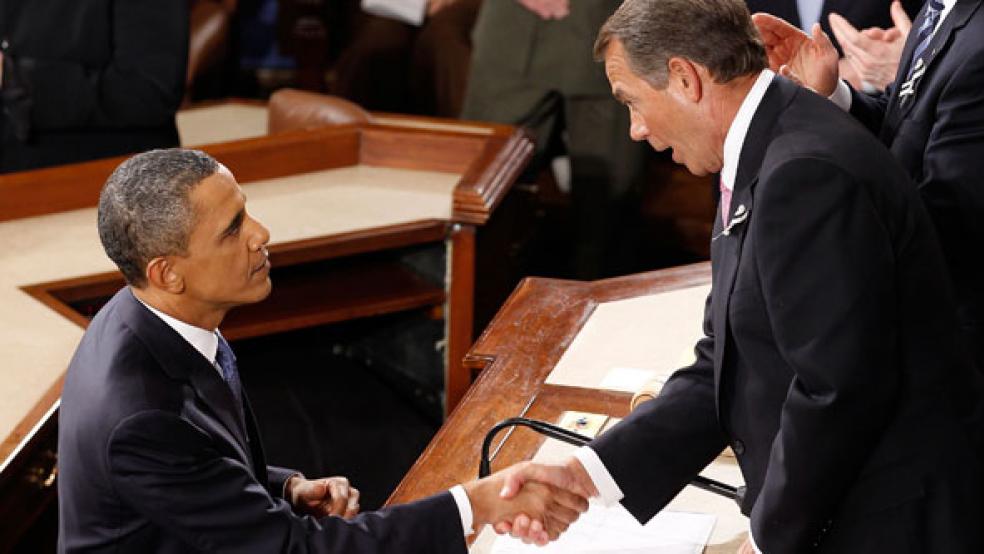If you look closely enough, you can see the steam rising from the dome of the U.S. Capitol, as lawmakers brace for what is likely to be one of the most consequential budget and spending battles since Democratic President Bill Clinton went to the mat with Republican congressional leaders Newt Gingrich and Bob Dole back in the mid 1990s.
The looming conflict between President Obama and the scrappy conservative Republicans and Tea Party activists in the House and Senate is likely to get downright ugly before differences are finally resolved – with the outside possibility of a government shutdown by the end of this week. There will be bruising fights over virtually every facet of federal budget policy – from reordering spending levels for scores of domestic programs and government agencies to possible cuts in defense to the funding of Medicaid and other entitlements to the implementation of the new health care reform and financial regulation laws.
With a big push from scores of combative conservative and Tea Party freshmen, Republican leaders in the House and Senate are demanding massive cuts in spending for the remainder of the current fiscal year and more consequential budget savings and entitlement reforms in the coming years to address the deficit. Many are threatening to prompt a government shutdown or even a default on U.S. borrowing if necessary to get their way. Obama and Senate Democratic leaders say they are willing to meet the Republicans half way in responding to their demands for more spending cuts – but will go just so far before digging in their heels.
William Gale, a senior fellow in economics at the Brookings Institution, says that the fixation on whether politicians can avert a government shutdown late this week or prevent the Treasury from defaulting on bonds later this summer are distractions from more fundamental challenges – including the long-term debt, reining in defense spending and raising tax revenue. “As usual, politicians aren’t discussing the right issues,” he said. “The big issues are fundamental, but they are not these crises everyone is running around about.”
But Republicans say they won’t turn their attention to more fundamental, long-term issues until they have it out with the White House and Democrats over more immediate concerns. And they are driving the agenda for the time being. So for those keeping score, here are six of the hottest, most pressing fiscal issues to keep an eye on in the coming days and months:
1. Spending Cuts 
Just about everyone in Washington is holding his breath to see whether there will be a government shutdown this weekend – something that a majority of experts surveyed by The Fiscal Times predicted will occur. But no one wants to be held responsible for a shutdown – especially Republicans who got blamed by voters for the last two shutdowns, back in late 1995 and early 1996.
So House Speaker John Boehner, R-Ohio, and Senate Republican Leader Mitch McConnell of Kentucky will have to decide later this week whether to accept an offer by the White House and Senate Majority Leader Harry Reid, D-Nev., to cut a total of $33 billion from domestic spending for the remaining six months of fiscal 2011, or insist on the $61 billion the House passed earlier this year. Some Tea Party freshman are insisting on even more in savings, to fulfill a campaign pledge to slash $100 billion from this year’s budget.
Vice President Biden entered the talks last week, and signaled – probably prematurely – that a deal was at hand. Boehner has dampened optimism with a series of ominous warnings that the two sides are still far apart, promising to “fight for the largest spending cuts that we can get to keep the government open.” Even if the dueling sides agree at the last minute to a budget plan to get them through the remainder of the year, there may not be enough time to work out the details, and they may have to agree to a seventh and final temporary spending resolution before they seal the deal.
A major stumbling block to a final deal are the so called “policy riders” or amendments which take direct aim at many programs important to the Obama administration and Democrats. One rider would cut $600 million from funding for Planned Parenthood and other health care services for low-income, uninsured women. Another provision strongly backed by the 87 House GOP freshmen would defund Obama’s signature health care law. Republicans also want to strip $1.6 billion from the Environmental Protection Agency’s budget to cut overall funding by almost 30 percent below last year’s levels. They would also eliminate funding for the Corporation for Public Broadcasting. Democrats have called the riders non-starters in the increasingly strident and high octane debate.
2. The Debt Ceiling 
Raising the debt ceiling has never been an easy lift for Congress and the White House, but this year it will be exceptionally difficult. The debt ceiling, first imposed by Congress in 1917, limits the amount of obligations that may be issued by the U.S. government to finance its general activities or that can be borrowed from trust funds, including Social Security, to fund daily operations.
Congress has voted to raise the debt limit 10 times since 2001 after the usual squabbles and accusations about which party drove up spending more. But this year, the new crop of freshmen lawmakers closely aligned with the Tea Party are threatening to vote against or filibuster legislation to raise the ceiling unless it’s linked to a plan for long-term deficit reduction, and tax and entitlement reforms. Just last week, Sen. Marco Rubio, a prominent conservative Florida freshman, came out against authorizing an increase to the limit, arguing that doing so would be “putting off the tough decisions until after the next election.”
With the federal budget deficit projected to rise to $1.6 trillion this year, the government is on course to breach the $14.3 trillion statutory debt ceiling (the accumulation of all of its deficits) between April 15 and May 31 – potentially triggering the first default on borrowing in U.S. history. Federal Reserve Chairman Ben Bernanke and Treasury Secretary Timothy F. Geithner have warned of “catastrophic” economic consequences if the government defaults on its obligations. There are a few gimmicks the Treasury can use to buy some additional time, but once those are exhausted the government would begin shutting down, Social Security checks would be held up, and the financial markets would likely tank.
3. Long-term budget reforms 
There is no shortage of ideas in Washington for how to go about fixing the long-term deficit. By one count, there are at least a dozen proposals – large and small – for containing long-term domestic and defense spending, Medicare, Medicaid and other health care programs, overhauling the tangled tax code, revamping Social Security and putting the government on a more sustainable fiscal path.
The two plans that have gotten the most attention were issued late last year by the president’s fiscal commission, co-chaired by Democrat Erskine Bowles and Republican Alan Simpson, and a Bipartisan Policy Center taskforce, chaired by Democrat Alice Rivlin and Republican Pete V. Domenici. Both draw on a full arsenal of tax and spending measures – including cuts in defense and entitlement programs and tax increases – to sharply reduce budget deficits and stabilize the national debt by 2014.
There have been a few optimistic signs of a growing consensus to do something significant this year to address the debt, which is on course to reach 90 percent of the gross domestic product by 2020 unless there is a major course correction. Sixty-four Democratic and Republican senators recently signed a letter urging Obama to get involved in developing a “comprehensive” deficit reduction package, along the lines of the recommendations of his fiscal commission for $4 trillion of deficit reduction in the coming decade.
Behind that effort is a group of six senators that includes some of the Senate’s most influential members. The so-called “Gang of Six" includes Saxby Chambliss, R-Ga., and Tom Coburn, R-Okla., who are personal friends of House Speaker John Boehner; Mark Warner, D-Va., a former governor; Mike Crapo, R-Idaho, a close adviser to Senate Republican Leader Mitch McConnell of Kentucky, Senate Budget Committee Chairman Kent Conrad, D-N.D., one of Capitol Hill’s most influential deficit hawks, and Richard J. Durbin of Illinois, the No. 2 Democrat in the Senate.
The group has said that their goal in seeking to cut the deficit is a more prosperous economy and a reduced threat that the United States will face the same kind of debt crisis that has prompted painful and controversial reforms in Greece, Portugal, Ireland and other European countries. Whether they will have any more success than some of their deficit-minded predecessors remains to be seen.
4. Medicaid 
Federal and state officials desperate to control runaway health care costs are zeroing in on Medicaid, the monster health insurance program for low-income and disabled people, for massive savings in the coming years. Medicaid will cost the federal government and the states a record $465 billion this year, and that cost could more than double by 2021 without a substantial policy shift.
House Budget Committee Chairman Paul Ryan, R-Wis., will unveil a long-term GOP budget plan this week including as much as $1 trillion in Medicaid cuts over the coming decade, a far cry from the $58 billion of savings over the next 10 years that President Obama’s fiscal commission proposed. Medicaid accounts for an average of 22 percent of all state spending, with Medicaid rolls expected to grow substantially under President Obama’s health care reform legislation.
Haley Barbour of Mississippi and many other Republican governors are pressing for changes in the law to give the states more flexibility to reduce their costs – such as by converting Medicaid from an entitlement program to a block grant. More than half the states are reducing Medicaid services and payments to health care providers this year, in the wake of recessionary pressures that rocketed enrollments of poor women, children and the elderly to record levels and drained state treasuries.
5. Defense 
With the U.S. embarked on a third military mission in the Middle East, efforts to rein in Pentagon spending are once again on the backburner – but they can’t stay there long. Unlike domestic discretionary programs, military spending is scheduled for a steady diet of small increases over the next decade, and that’s on top of a budget that in inflation-adjusted dollars is already 20 percent higher than at the peak of the Reagan-era build-up.
With long-term procurement projects experiencing major cost-overruns, according to a recently released Government Accountability Office report, it won’t be long before Congress and the White House come face to face with the fact that any meaningful deficit reduction plan must tackle defense. The president’s bipartisan deficit commission recommended a dollar in defense cuts for every dollar in cuts to domestic discretionary spending.
Here are a couple of places to start. Every branch of the service is slated to adopt the advanced Joint Strike Fighter over the next quarter century, a nearly $400 billion program. Experts say the Pentagon could substantially cut its costs by limiting the program and buying updated versions of older models, which are already more advanced than anything else other countries can put in the air. Ditto for the Navy’s 10 aircraft carrier groups and its destroyer replacement program. Critics of defense spending ask, why maintain the fleet at levels necessary to refight the naval battles of World War II when the military engages almost exclusively in limited strategic missions to counter terrorism and deal with failed states?
6. Taxes 
While there has been plenty of talk about the need to reform the U.S. tax code to eliminate gross inequities and loopholes, the only real push we are likely to see this year is to lower the 35 percent corporate tax rate, which is among the highest of any nation besides Japan. U.S. companies say the tax rate puts them at a major competitive disadvantage.
The U.S. tax system hasn’t been revised since 1986 during the Reagan administration, but businesses say the time is ripe to lower the rate now, while the economy climbs out of recession. Cisco and other U.S. multinational corporations say they would be likely to move their profits from foreign countries back into the United States if the tax rate came down – thereby stimulating hiring and investment. But President Obama insists that any tax reform be “revenue neutral,” so how to offset the cost of a stiff cut in the corporate tax is a big sticking point.
The scores of special tax exclusions, credits and loopholes that companies have long enjoyed are some of the most visible targets lawmakers will turn to in order to offset the revenues that would be lost through a reduction in the corporate tax rate. House Ways and Means Committee Chairman Dave Camp’s recent bill to reduce the top tax rate for individuals and corporations to 25 percent would whack away at some of those tax breaks. But doing away with special tax treatment for businesses is likely to impact different-sized firms differently, and could ignite tensions within the business community. “With revenue-neutral reform, there will always be winners and losers, and that will blow apart the business coalition,” said Marty Sullivan, an economist and contributing editor at Tax Analysts.
Merrill Goozner and Michelle Hirsch of the Fiscal Times contributed to this article
Related Links:
Republicans Eye Bigger Cuts Amid Budget Fight (Reuters)
John Boehner Faces Moment of Truth (POLITICO)
John Boehner Caught Between Barack and a Tea Party (New York Magazine)






